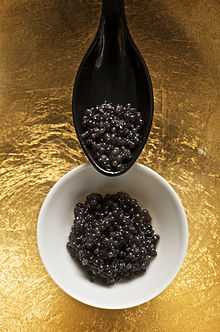Beluga caviar
.jpg)

Beluga caviar is caviar consisting of the roe (or eggs) of the beluga sturgeon Huso huso. It is found primarily in the Caspian Sea, the world’s largest salt-water lake, which is bordered by Iran and the CIS countries of Azerbaijan, Kazakhstan, Russia, and Turkmenistan. It can also be found in the Black Sea basin and occasionally in the Adriatic Sea. Beluga caviar is the most expensive type of caviar,[1] with present market prices ranging from $7,000 to $10,000/kg ($3,200 to $4,500/lb).[2][3]
Harvesting
The Beluga sturgeon is currently considered to be critically endangered, causing the United States Fish and Wildlife Service to ban in 2005 the importation of Beluga caviar which originated in the Caspian Sea and Black Sea basin. In 2006, the Convention on International Trade in Endangered Species (CITES) suspended all trade made with the traditional caviar-producing regions of the Caspian and Black Seas (Beluga, Ossetra and Sevruga), (Azerbaijan, Bulgaria, China, Iran, Kazakhstan, Romania, Russia, Serbia and Montenegro, Turkmenistan, and Ukraine) due to the producing countries' failure to apply international regulations and recommendations.[4] Caviar from Iran is exempted from the ban. Iran is considered by CITES to practice effective conservation and policing of its fisheries.[5] In January 2007, this ban was partly lifted, allowing the sale of 96 tons of caviar, 15 per cent below the official 2005 level.[6] CITES maintained the 2007 quotas for 2008, drawing criticism for doing little to protect the declining sturgeon population.[7]
The Beluga sturgeon can take up to 20 years to reach maturity. The fish harvested for caviar are often nearly 900 kg (2,000 lb). The eggs themselves are the largest of the commonly used roes, and range in color from dark gray (almost black) to light gray, with the lighter colors coming from older fish, and being the most valued. A pearly white variety, called Gawad (Persian for diamond), taken from a centennial female sturgeon, is the rarest type of Beluga available, with an extremely small production and prices reaching almost £25,000 per kilogram.[8]
Any additions by producers diminish the value of the roe, and the caviar usually reaches the market without any additions or processing whatsoever.
Service
Any fine caviar, perhaps especially Beluga is to be enjoyed with as little embellishment as possible. most people will simply dollop a (mother of pearl or another non-metallic) spoonful onto the back of their hand near the webbing between the thumb and forefinger and enjoy it that way, so others can use the spoon without "double dipping" A fine champagne or vodka to wash it down is usually all that a connoisseur will use. for a more filling caviar experience, one can serve blini, or perhaps cold, boiled potato halves, but fine caviar is almost never enjoyed with diced onions or eggs, as that would surely effect the subtle flavors and texture that makes beluga and other fine caviar the delicacy that they are.
As with most caviars, Beluga is usually handled with a spoon made of mother of pearl, bone, or other non-metallic material, as metal utensils tend to impart an unwelcome metallic taste to the delicate and expensive roe.[9] But Beluga caviar, unlike less expensive varieties, is usually served by itself on toast, whereas other caviars can be served in a variety of ways, including hollowed and cooked new potatoes, on a blini, or garnished with sour cream, crème fraîche, minced onion or minced hard boiled egg whites. The higher-grade caviars, including Beluga, usually receive very little embellishment. These items can, however, be served with Beluga to be used as palate cleansers.
References
- ↑ Expensive ingredients | Top 5 world's most expensive ingredients - Yahoo Lifestyle India
- ↑ Young, Mark C. (1999). Guinness Book of World Records. p. 94.
- ↑ Schmidt, Arno (2003). Chef's Book of Formulas, Yields, and Sizes. p. 48.
- ↑ "BBC - International caviar trade banned, 2006". BBC News. 2006-01-03. Retrieved 2012-10-22.
- ↑ "The Nibble, "Caspian Caviar Update: News About The World’s Favorite Roe", 2006". Thenibble.com. Retrieved 2012-10-22.
- ↑ "UN lifts embargo on caviar trade". BBC News. 2007-01-02. Retrieved 2008-05-30.
- ↑ "Beluga Sturgeon Threatened With Extinction, Yet Caviar Quotas Remain Unchanged". 2008-03-06. Archived from the original on 19 September 2008. Retrieved 2008-09-15.
- ↑ "Almas Beluga is the world’s most expensive Caviar". Luxury Launches. Retrieved February 1, 2013.
- ↑ Fabricant, Florence (2003). The New York Times Seafood Cookbook. p. 287.